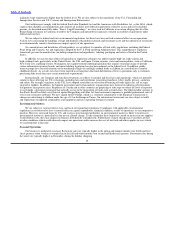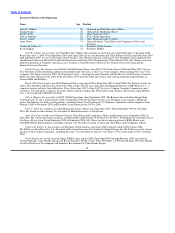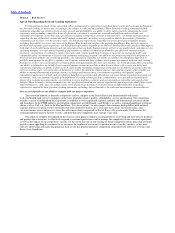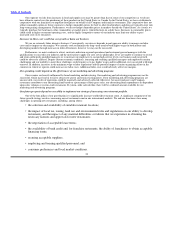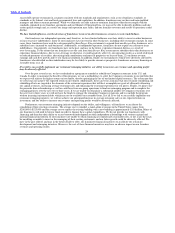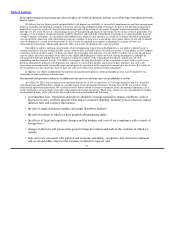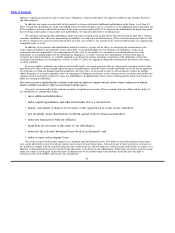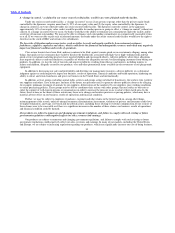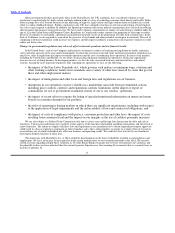Burger King 2010 Annual Report Download - page 25
Download and view the complete annual report
Please find page 25 of the 2010 Burger King annual report below. You can navigate through the pages in the report by either clicking on the pages listed below, or by using the keyword search tool below to find specific information within the annual report.
Table of Contents
We expect that most of our growth will be accomplished through the opening of additional franchise restaurants. However, our
franchisees may be unwilling or unable to increase their investment in our system by opening new restaurants, particularly if their
existing restaurants are not generating positive financial results. Moreover, opening new franchise restaurants depends, in part, upon the
availability of prospective franchisees with the experience and financial resources to be effective operators of Burger King restaurants.
In the past, we have approved franchisees that were unsuccessful in implementing their expansion plans, particularly in new markets.
There can be no assurance that we will be able to identify franchisees who meet our criteria, or if we identify such franchisees, that they
will successfully implement their expansion plans.
Approximately 90% of our current restaurants are franchised and this restaurant ownership mix presents a number of
disadvantages and risks.
Approximately 90% of our current restaurants are franchised and we expect that the percentage of Company restaurants may be
significantly reduced over the next five years as we accelerate the pace of refranchisings as part of our portfolio management strategy.
Although we believe that this restaurant ownership mix is beneficial to us because the capital required to grow and maintain our system
is funded primarily by franchisees, it also presents a number of drawbacks, such as our limited influence over franchisees and reliance
on franchisees to implement major initiatives, limited ability to facilitate changes in restaurant ownership, limitations on enforcement of
franchise obligations due to bankruptcy or insolvency proceedings and inability or unwillingness of franchisees to participate in our
strategic initiatives. Moreover, as the percentage of franchise restaurants increases, the problems associated with these drawbacks may
be exacerbated and may present a significant challenge for management.
Our principal competitors may have greater influence over their respective restaurant systems than we do because of their
significantly higher percentage of Company restaurants and/or ownership of franchisee real estate. McDonalds and Wendy’s have a
higher percentage of Company restaurants than we do, and, as a result, they may have a greater ability to implement operational
initiatives and business strategies, including their marketing and advertising programs.
Franchisee support of our marketing and advertising programs is critical for our success.
The support of our franchisees is critical for the success of our marketing programs and any new capital intensive or other strategic
initiatives we seek to undertake, and the successful execution of these initiatives will depend on our ability to maintain alignment with
our franchisees. While we can mandate certain strategic initiatives through enforcement of our franchise agreements, we need the active
support of our franchisees if the implementation of these initiatives is to be successful. In addition, our efforts to build alignment with
franchisees may result in a delay in the implementation of our marketing and advertising programs and other key initiatives. Although
we believe that our current relationships with our franchisees are generally good, there can be no assurance that our franchisees will
continue to support our marketing programs and strategic initiatives. We have been sued by the National Franchisee Association, Inc.,
an organization that represents over 50% of our franchisees in the United States, and several individual franchisees over the Company’s
decision to require U.S. franchisees to sell the 1/4 lb. Double Cheeseburger and the Buck Double at no more than $1.00. We were also
sued by four franchisees in Florida over extended hours of operation, which is one of our important initiatives to drive higher sales. The
failure of our franchisees to support our marketing programs and strategic initiatives could adversely affect our ability to implement our
business strategy and could materially harm our business, results of operations and financial condition.
Our operating results are closely tied to the success of our franchisees; however, our franchisees are independent operators and we
have limited influence over their restaurant operations.
Our operating results substantially depend upon our franchisees’ sales volumes, restaurant profitability, and financial viability.
However, our franchisees are independent operators and we cannot control many factors that impact the profitability of their restaurants.
Pursuant to the franchise agreements and our Manual of Operating Data, we can, among other things, mandate menu items, signage,
equipment, hours of operation and value menu, establish operating procedures and approve suppliers, distributors and products.
However, the quality of franchise restaurant operations may be diminished by any number of factors beyond our control. Consequently,
franchisees may not
23





